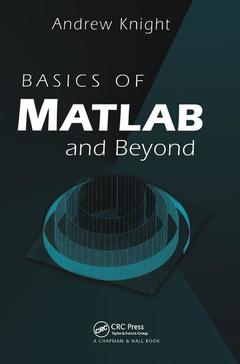Basics of MATLAB and Beyond
Auteur : Knight Andrew

MATLABä-the tremendously popular computation, numerical analysis, signal processing, data analysis, and graphical software package-allows virtually every scientist and engineer to make better and faster progress. As MATLAB's world-wide sales approach a half-million with an estimated four million users, it becomes a near necessity that professionals and students have a level of competence in its use. Until now, however, there has been no book that quickly and effectively introduces MATLAB's capabilities to new users and assists those with more experience down the path toward increasingly sophisticated work.
Basics of MATLAB and Beyond is just such a book. Its hands-on, tutorial approach gently takes new users by the hand and leads them to competence in all the fundamentals of MATLAB. Then, with equal effectiveness, it covers the advanced topics that lead to full, creative exploitation of MATLAB's awesome power. With this book, readers will:
Based on the latest 5.x release, Basics of MATLAB and Beyond supplies both novice and experienced users the tools they need to gain proficiency, increase productivity, and ultimately have more fun with MATLAB.
First Steps in MATLAB. Typing into MATLAB. Matrices. Basic Graphics. More Matrix Algebra. Basic Data Analysis. Graphics of Functions of Two Variables. M-Files. Data Files. Directories. Startup. Using MATLAB on Different Platforms. Log Scales. Curve Fitting-Matrix Division. Missing Data
Polar Plots. Fourier Transform. Power Spectrum. Sounds in MATLAB. Time-Frequency Analysis. Line Animation
SPTool. Handle Graphics. Demos. Sparse Arrays. Text Strings. Cell Arrays. Structures. Multidimensional Arrays. Saving and Loading Data. Handle Graphics. Axes Effects. Text in Graphics. Graphical user Interfaces. Printing Graphics. Irregular Grids. Three-Dimensional Modeling. MATLAB Programming. Answers to Exercises. Index.
NTI/Sales Copy
Date de parution : 06-2019
15.6x23.4 cm
Disponible chez l'éditeur (délai d'approvisionnement : 14 jours).
Prix indicatif 208,65 €
Ajouter au panierThèmes de Basics of MATLAB and Beyond :
Mots-clés :
Handle Graphics; View Point; data processing; GUI Element; MATLAB's world-wide sales; RGB Image; engineering mathematics; FFT Size; Matlab Command; Ascii Value; Edit Box; Cell Array; Australian Population Data; Tick Mark Labels; Encapsulated PostScript File; Signal Processing Toolbox; EPS; Tick Marks; Tick Labels; Multidimensional Arrays; Plot Command; Fred Flintstone; Colour Map; Vertex Colours; Graphical Object; Axis Command



